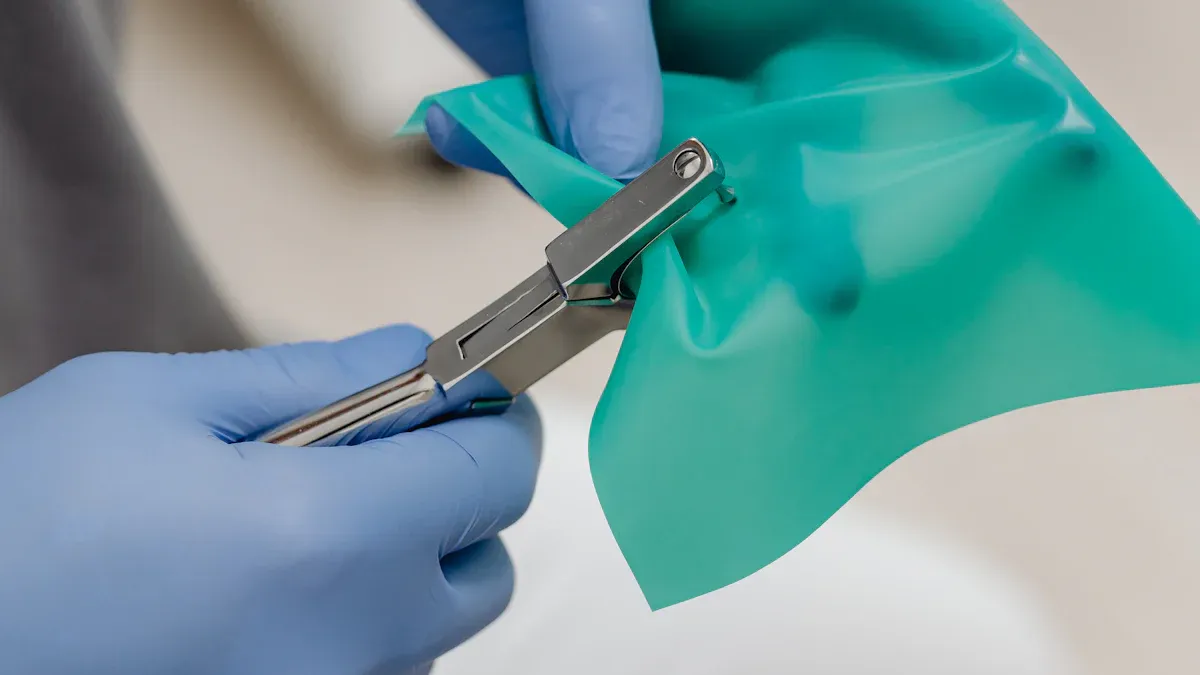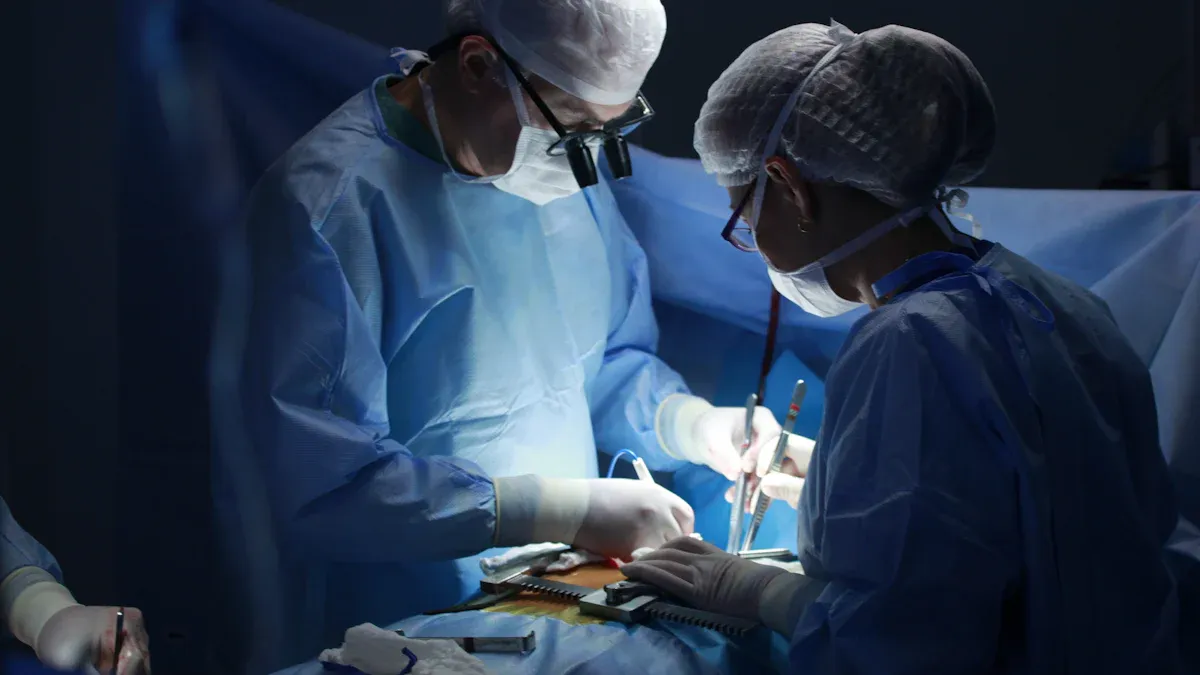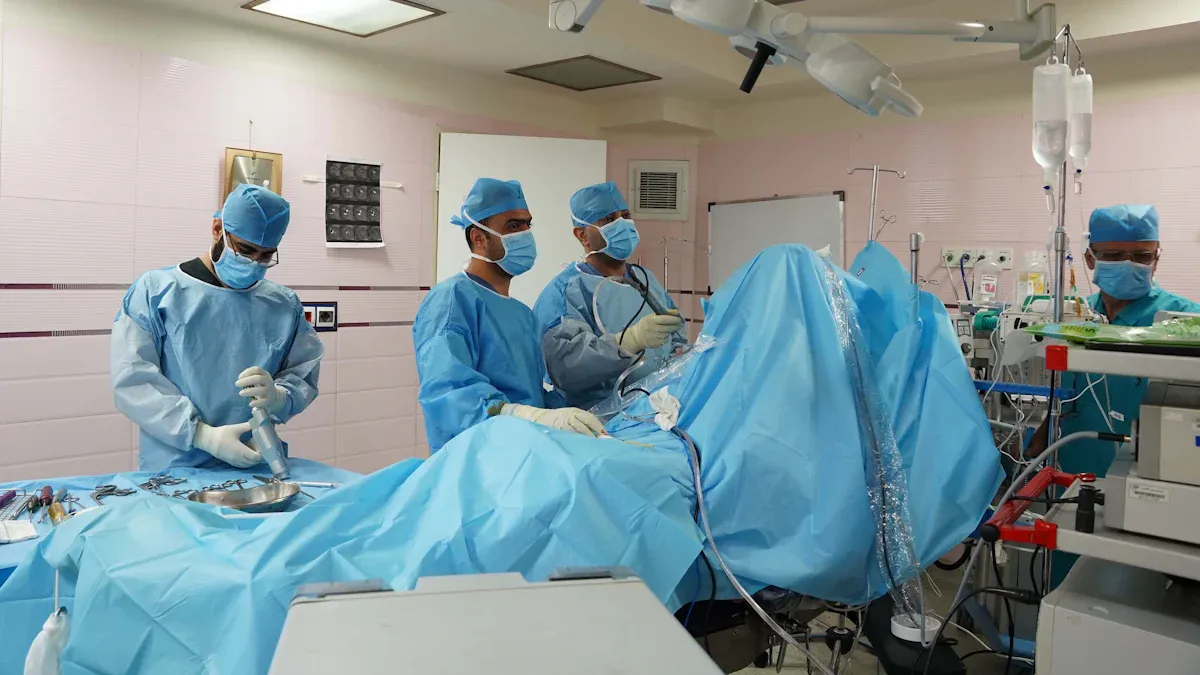How to Choose Nitinol Guidewires for Complex Medical Procedures

Choosing the right Nitinol guidewires plays a crucial role in the success of complex medical procedures. These Nitinol guidewires exhibit unique properties, such as shape memory and superelasticity, which enhance precision and reduce complications. Clinical studies highlight the importance of Nitinol guidewires in improving outcomes. For instance, the CiTop™ Expander™ Nitinol guidewire achieved a 70% procedural success rate in chronic total occlusion cases, demonstrating its specialized design. Such advancements in Nitinol guidewire technology, combined with careful selection, ensure safer and more effective interventions, benefiting both patients and practitioners.
Key Takeaways
Nitinol guidewires are special because they can remember shapes and bend easily, making them great for tricky medical procedures.
Being flexible and easy to control helps guidewires move safely through hard-to-reach body areas.
Picking the right tip shape and strong materials is important to avoid harm and guide accurately during procedures.
Talking to medical experts can help you choose the best guidewire for specific needs.
Spending more on good Nitinol guidewires can improve patient care and lower risks, making the cost worth it.
Unique Properties of Nitinol Guidewires

Nitinol guidewires possess unique properties that make them indispensable in complex medical procedures. These properties, including shape memory, superelasticity, flexibility, and durability, contribute to their effectiveness and reliability in challenging environments.
Shape memory and superelasticity
Nitinol guidewires exhibit remarkable shape memory and superelasticity, which enhance their performance in medical applications. Shape memory allows the guidewire to return to its original shape after deformation when exposed to heat. This phenomenon occurs due to a transformation in the material's crystal structure between austenite and martensite phases. Superelasticity, on the other hand, enables the guidewire to endure significant stress and revert to its original form when the stress is removed. This property becomes active when the material is deformed above its transformation temperature.
These characteristics ensure that Nitinol guidewires maintain their structural integrity during intricate procedures. For example, when navigating tortuous anatomical pathways, the guidewire can bend and flex without permanent deformation. Manufacturers like AccuPath leverage these properties in their Nitinol tubing, ensuring high-quality products for medical professionals.
Flexibility and resistance to kinking
Flexibility is a critical factor in the selection of guidewires for complex procedures. Nitinol guidewires excel in this area due to their ability to bend and adapt to challenging anatomical structures. Their resistance to kinking further enhances their usability, as they can maintain smooth navigation even in tight or curved spaces. This property reduces the risk of procedural complications and ensures precise placement.
AccuPath's Nitinol tubing is designed with advanced manufacturing techniques to optimize flexibility and kink resistance. These features make their guidewires a reliable choice for medical professionals seeking consistent performance in demanding environments.
Durability and fatigue resistance
Durability and fatigue resistance are essential for guidewires used in repetitive or high-stress medical procedures. Nitinol guidewires demonstrate exceptional fatigue resistance, allowing them to endure millions of stress cycles without failure. This resilience stems from the material's unique mechanical properties and precise manufacturing processes. Fatigue testing has shown that Nitinol can survive up to 10⁷ cycles under strain amplitudes ranging from 0.5% to 2.9%, ensuring reliability in high-stress environments.
AccuPath's Nitinol tubing undergoes rigorous testing to meet these standards, providing medical professionals with durable and dependable guidewires. This level of reliability minimizes the need for frequent replacements, reducing costs and improving procedural efficiency.
Factors to Consider When Choosing a Guidewire

Flexibility and maneuverability
Flexibility and maneuverability are critical attributes when selecting a guidewire for complex medical procedures. These properties determine how effectively the guidewire can navigate intricate anatomical pathways, such as tortuous blood vessels or narrow passages. A guidewire with superior flexibility minimizes the risk of vessel damage, ensuring safer outcomes for patients. Maneuverability, on the other hand, allows precise control during procedures, which is essential for accessing hard-to-reach areas.
The neurovascular applications segment is projected to grow significantly between 2025 and 2030 due to advancements in guidewire design. These innovations focus on improving flexibility and maneuverability, enabling safer and more effective navigation through complex brain vessels.
Manufacturers are investing in technologies that enhance torque transmission and visibility, which are vital for maneuverability. These improvements not only address specific clinical needs but also ensure cost-effectiveness. For example, guidewires designed for neurovascular procedures often feature advanced coatings and materials that reduce friction, allowing smoother movement through delicate structures. Such advancements highlight the importance of flexibility and maneuverability in guidewire selection.
Tip design and material quality
The tip design and material quality of a guidewire significantly impact its safety and efficacy. The tip serves as the primary point of contact with the patient's anatomy, making its design crucial for precise navigation and reduced trauma. Rounded or tapered tips are commonly used to minimize the risk of vessel injury. Additionally, the stiffness or softness of the tip can be tailored to the specific requirements of the procedure.
Materials like stainless steel and Nitinol are frequently chosen for their biocompatibility and strength. Nitinol, in particular, offers unique properties such as superelasticity and shape memory, which are essential for navigating complex vascular structures.
Surface treatments, such as electropolishing and hydrophilic coatings, further enhance the performance of guidewires. These treatments reduce friction, allowing the guidewire to glide smoothly through blood vessels. Engineering variations in stiffness along the guidewire's length also improve navigation and pushability. These features ensure that the guidewire performs reliably in challenging environments, enhancing procedural success and patient safety.
Compatibility with specific medical procedures
Guidewire selection must align with the specific requirements of the medical procedure. Each procedure presents unique challenges, such as the complexity of the anatomy or the need for specialized tools. For instance, neurovascular procedures demand guidewires with exceptional flexibility and precise control, while cardiovascular interventions may require guidewires with enhanced torque and durability.
The FAME study demonstrated that the PressureWire™ X Guidewire improves the identification of hemodynamically relevant stenoses. This guidewire reduced mortality or myocardial infarction by 34% over two years and lowered procedure costs by 14%.
Understanding the patient's needs is a crucial step in guidewire selection. Factors such as vessel size, lesion location, and procedural complexity should guide the choice of guidewire. Consulting with experienced professionals can provide valuable insights into the latest technologies and their applications. Staying informed about advancements in guidewire design ensures that medical professionals can select the most appropriate tool for each procedure, ultimately improving patient outcomes.
Evaluating Nitinol Guidewire Options
Consulting with medical experts
Consulting medical experts plays a vital role in the selection of nitinol guidewires. Their insights help identify the most suitable guidewire based on procedural requirements and the patient's needs. Experts often evaluate key components such as the core, tip, body, and coating of the guidewire. Each component contributes to performance during complex medical procedures.
Component | Description |
|---|---|
Core | Nitinol core offers flexibility and trackability, while stainless steel provides support and pushability. |
Tip | Design affects torqueability and penetration power; tapered tips enhance penetration. |
Body | Composed of spring coils or polymers, affecting deliverability. |
Coating | Hydrophobic coatings enhance tactile feedback; hydrophilic coatings improve slipperiness for navigating complex vessels. |
Medical professionals also assess how these features align with the specific challenges of the procedure. Their expertise ensures that the guidewire selection process prioritizes safety, precision, and efficiency.
Assessing technological advancements
Technological advancements in nitinol guidewires have significantly improved their performance and versatility. Innovations such as combining nitinol with stainless steel enhance flexibility and shape recovery, enabling precise navigation through challenging vessel segments. Coatings like silicone or PTFE improve lubricity, facilitating smoother movement in complex vascular environments.
Nitinol guidewires exhibit flexibility and shape memory, allowing them to adapt to intricate anatomical pathways.
Enhanced durability ensures reliability during procedures, improving patient safety and comfort.
Ongoing research focuses on optimizing performance metrics, making nitinol guidewires suitable for a broader range of medical applications.
These advancements highlight the importance of staying informed about emerging technologies. Medical professionals can leverage these innovations to improve procedural outcomes and meet the evolving needs of patients.
Comparing performance metrics and specifications
Comparing performance metrics and specifications is essential for selecting the right guidewire. Factors such as flexibility, torqueability, and durability determine how effectively the guidewire performs under procedural stress. For example, nitinol guidewires excel in maintaining shape memory and resisting fatigue, ensuring consistent performance during repetitive use.
Medical professionals often evaluate specifications like coating type, tip design, and body composition to match the guidewire with procedural demands. Hydrophilic coatings improve slipperiness, while tapered tips enhance penetration power. These features contribute to smoother navigation and reduced risk of vessel damage.
By comparing these metrics, practitioners can make informed decisions that align with the patient's needs and procedural complexity. This approach ensures that the selected guidewire delivers optimal results while maintaining safety and efficiency.
Cost Considerations for Nitinol Guidewires
Understanding price ranges and budget constraints
Nitinol guidewires are priced higher than conventional guidewires due to their advanced materials and manufacturing processes. While standard guidewires typically cost between $200 and $1,000, Nitinol options often exceed this range. This premium pricing reflects the superior quality, durability, and performance of Nitinol. However, affordability becomes a challenge in regions with limited healthcare budgets. Emerging economies, which allocate approximately 5% of their GDP to healthcare, may struggle to justify the higher costs of these devices.
The Nitinol Guide Wire Market Report highlights how market segmentation and trends influence pricing strategies. Factors such as titanium content and the complexity of manufacturing processes significantly impact production costs. High purity Nitinol, known for its refined quality and precision, commands a premium price. Despite the higher upfront cost, the long-term benefits of reliability and reduced procedural complications make Nitinol guidewires a valuable investment.
Balancing cost with quality and performance
Balancing cost with quality and performance is essential when selecting Nitinol guidewires. While these guidewires are more expensive than stainless steel alternatives, their enhanced flexibility and durability justify the investment. For example, Nitinol guidewires reduce procedural complications and improve outcomes, making them ideal for complex medical procedures. In contrast, stainless steel guidewires, though more affordable, are better suited for standard procedures.
Feature | Nitinol Guidewires | Stainless Steel Guidewires |
|---|---|---|
Cost | Higher due to complex manufacturing | Lower due to simpler production |
Flexibility | Superior flexibility and maneuverability | Stiffer and less adaptable |
Performance Benefits | Fewer complications, better outcomes | Adequate for standard procedures |
Application Suitability | Preferred for complex procedures | Suitable for standard procedures |
This comparison underscores the importance of aligning guidewire selection with the patient's needs and procedural demands. Investing in high-quality Nitinol guidewires ensures better performance and patient safety.
Tips for maximizing value for money
Maximizing value for money requires careful selection and strategic purchasing. Medical professionals should evaluate the specific requirements of each procedure and choose guidewires that offer the best balance of cost and performance. Consulting with manufacturers or suppliers can provide insights into bulk purchasing discounts or cost-effective options.
Staying informed about market trends and technological advancements also helps optimize spending. For instance, innovations in Nitinol manufacturing may lead to more affordable options without compromising quality. Additionally, selecting guidewires with proven durability reduces the need for frequent replacements, further lowering long-term costs.
Tip: Prioritize guidewires that align with procedural needs while offering durability and reliability. This approach ensures cost-effectiveness without sacrificing quality.
Nitinol guidewires offer unique properties that enhance their performance in complex medical procedures. Their shape memory, superelasticity, and durability ensure reliable navigation through challenging anatomical pathways. These features improve procedural outcomes and reduce complications.
Selecting the right guidewire requires careful consideration of flexibility, tip design, and compatibility with the procedure. Each factor plays a role in meeting the patient's needs and ensuring safety during interventions.
Expert advice and thorough evaluation remain essential for making informed decisions. Medical professionals can leverage their expertise to match guidewire specifications with procedural demands, optimizing both performance and patient care.
FAQ
What makes Nitinol guidewires superior to other medical wire materials?
Nitinol guidewires offer unmatched flexibility, shape memory, and superelasticity. These properties enhance their performance during cardiovascular interventions and other complex procedures. Their biocompatibility ensures patient safety, making them a preferred guidewire medical device.
How does biocompatibility impact the quality of guidewire medical devices?
Biocompatibility ensures that guidewires interact safely with human tissues. It reduces the risk of adverse reactions, enhancing the quality and reliability of medical wire materials used in cardiovascular interventions.
Are Nitinol guidewires suitable for all types of procedures?
Nitinol guidewires excel in complex procedures requiring flexibility and durability. They perform well in cardiovascular interventions but may not be ideal for simpler tasks where cost-effective alternatives suffice.
How do manufacturers ensure the performance of Nitinol guidewires?
Manufacturers optimize performance by refining medical wire materials, applying advanced coatings, and conducting rigorous testing. These steps improve durability, flexibility, and overall quality, ensuring reliable outcomes in medical procedures.
Why are Nitinol guidewires more expensive than other options?
Nitinol guidewires involve advanced manufacturing processes and premium materials. Their superior performance, durability, and biocompatibility justify the higher cost, especially for complex cardiovascular interventions.
See Also
A Comprehensive Approach to Choosing Nitinol Tubing Wisely
The Importance of Nitinol Tubing in Minimally Invasive Surgery
Choosing the Ideal Nitinol Tubing Supplier for Your Requirements
Understanding the Manufacturing Process of Nitinol Tubing for Medicine
Detailed Process for Creating Nitinol Microtubing in Neurovascular Uses

